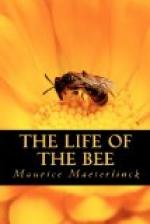A few days more, and the lids of these myriad urns—whereof a considerable hive will contain from sixty to eighty thousand—will break, and two large and earnest black eyes will appear, surmounted by antennae that already are groping at life, while active jaws are busily engaged in enlarging the opening from within. The nurses at once come running; they help the young bee to emerge from her prison, they clean her and brush her, and at the tip of their tongue present the first honey of the new life. But the bee, that has come from another world, is bewildered still, trembling and pale; she wears the feeble look of a little old man who might have escaped from his tomb, or perhaps of a traveller strewn with the powdery dust of the ways that lead unto life. She is perfect, however, from head to foot; she knows at once all that has to be known; and, like the children of the people, who learn, as it were, at their birth, that for them there shall never be time to play or to laugh, she instantly makes her way to the cells that are closed, and proceeds to beat her wings and to dance in cadence, so that she in her turn may quicken her buried sisters; nor does she for one instant pause to decipher the astounding enigma of her destiny, or her race.
[65]
The most arduous labours will, however, at first be spared her. A week must elapse from the day of her birth before she will quit the hive; she will then perform her first “cleansing flight,” and absorb the air into her tracheae, which, filling, expand her body, and proclaim her the bride of space. Thereupon she returns to the hive, and waits yet one week more; and then, with her sisters born the same day as herself, she will for the first time set forth to visit the flowers. A special emotion now will lay hold of her; one that French apiarists term the “soleil d’artifice,” but which might more rightly perhaps be called the “sun of disquiet.” For it is evident that the bees are afraid, that these daughters of the crowd, of secluded darkness, shrink from the vault of blue, from the infinite loneliness of the light; and their joy is halting, and woven of terror. They cross the threshold and pause; they depart, they return, twenty times. They hover aloft in the air, their head persistently turned to the home; they describe great soaring circles that suddenly sink beneath the weight of regret; and their thirteen thousand eyes will question, reflect, and retain the trees and the fountain, the gate and the walls, the neighbouring windows and houses, till at last the aerial course whereon their return shall glide have become as indelibly stamped in their memory as though it were marked in space by two lines of steel.
[66]
A new mystery confronts us here, which we shall do well to challenge; for though it reply not, its silence still will extend the field of our conscious ignorance, which is the most fertile of all that our activity knows. How do the bees contrive to find their way back to the hive that they cannot possibly see, that is hidden, perhaps, by the trees, that in any event must form an imperceptible point in space? How is it that if taken in a box to a spot two or three miles from their home, they will almost invariably succeed in finding their way back?




